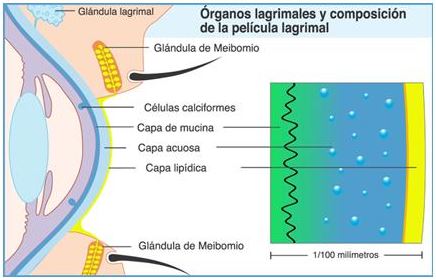What is dry eye syndrome?
Dry eye syndrome is a common condition caused by a chronic lack of lubrication and moisture on the surface of the eye, due to an insufficient production of tears.
With every blink, tears are distributed over the most superficial layer of the eye (cornea); they provide lubrication, reduce the risk of an eye infection and eliminate foreign bodies.
Request more information without obligation
What is the cause?
A suitable and uniform layer of tears on the surface of the eye is essential to maintaining correct vision.
A normal tear film consists of three components:
- An oily component (lipid)
- An aqueous component (aqueous)
- A component similar to mucous (mucin)


Each tear component is produced by various glands in or near to the eye:
- The oily component is produced by the meibomian gland in the eyelids.
- The aqueous component is produced by the lachrymal glands.
- The mucin component is produced by the goblet cells in the conjunctiva.
A problem with any of these sources of tear film components may cause dry eyes.
- Age: Dry eyes are part of the natural ageing process. Most people over the age of 65 may present symptoms.
- Gender: Women are more likely to develop dry eyes due to hormonal changes caused by pregnancy, use of oral contraceptives and menopause.
- Medication: antihistamines, nasal decongestants, antihypertensives and antidepressants can reduce the production of tears.
- Medical conditions: People with rheumatoid arthritis, diabetes and thyroid problems are more likely to present symptoms of dry eyes.
- Environmental conditions: Exposure to smoke, wind and dry climates may increase the evaporation of tears and cause symptoms of dry eyes. The lack of regular blinking, such as working in front of computer screens over extended periods of time, can also contribute.
What symptoms does it cause?
Sensation of “puncturing” or presence of foreign body, tiredness or eye pain, stinging, difficulty in blinking, eye redness, photophobia (sensitivity to light) and blurred vision.
The consequences of dry eye syndrome range from subtle but constant eye irritation to significant inflammation and even scarring on the surface of the eye.
What is the corresponding treatment?
The specific kind of dry eye will determine the type of treatment recommended by your ophthalmologist to alleviate the symptoms.
The various treatment options include:
Artificial tears.
- Tear duct plugs: Lachrymal ducts may be blocked with small silicone or gel plugs which can be removed, if necessary.

- Nutritional supplement of omega-3 fatty acids: helps to promote the production of tears.
- Treatment of the inflammation of the ocular surface or the eyelid.
- Self-care measures: Blinking regularly when you are reading or looking at a computer screen for extended periods of time, increasing moisture in the air at work or at home with humidifiers, wearing sunglasses and taking nutritional supplements which contain essential fatty acids.
In cases where the limbus is completely affected, in which there are no stem cells to repopulate the corneal surface, a conjunctival limbal autograft may be considered by obtaining the donor limbus from the other eye (if only one eye is affected).
The treatment of cases which affect both eyes consists of a keratolimbal allograft procedure involving a donor.
Cultivated stem cells have also been used to create grafts and be transplanted into patients with limbal deficiency.
A team of the highest professional standards
Central Ocular boasts a highly qualified professional medical team which has vast experience in presbyopia operations. Your vision could not be in better hands.
Cutting-edge technology
Our technological capabilities are based on the most advanced equipment which allows us to provide our patients undergoing presbyopia procedures with the best possible guarantees.
The best facilities
The outstanding facilities at Central Ocular mean that presbyopia procedures are performed in optimum conditions of safety and comfort for the patient. We make you feel right at home.
Our patients recommend us
The best form of publicity is provided by our patients who have undergone the presbyopia procedure. I wish I’d had it done sooner! A source of great satisfaction for the whole of our medical team.


